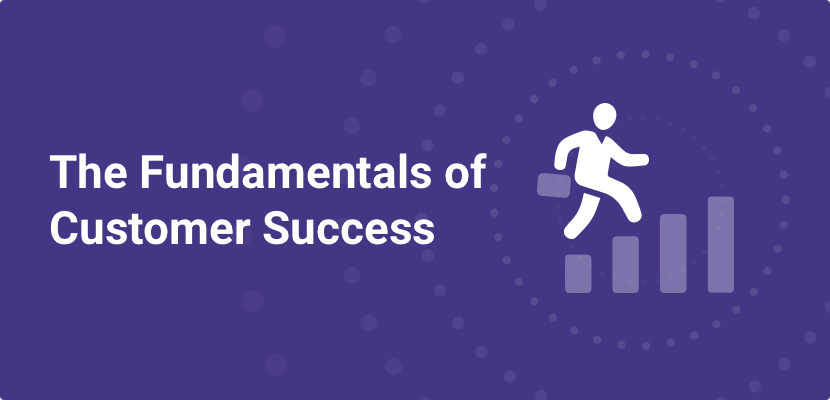70% of successful growing businesses say that customer success is very important to them. Only 49% of stagnant or declining companies say the same.
It’s clear that you should be fostering an emphasis on customer success if you want your company to succeed. But the best way to promote that mindset is less clear.
Fortunately, many companies have used customer success programs to better serve their customers. They’ve reduced churn, increased satisfaction, and built stronger, more dependable revenue. And they’ve shared their best practices.

We’re going to share 9 customer success best practices that you can put into action to better serve your customers.
Use these 9 Customer Success Best Practices
Before we get into the best practices themselves, though, it’s important to mention that they’re actually meant to be put into practice. We’re focusing on actionable advice here. Reading these points and then forgetting about them isn’t going to do any good.
As you’re reading through these best practices, think specifically about your business and how you can put them into action.
1. Understand What Success Means to Your Customers
If you only take away one thing from this list of customer success best practices, let it be this. Effectively supporting your customers, requires that you know what it is they’re trying to do.
You probably think you already know. And you very well might.
But you need to be absolutely sure.
That means you need to talk to your customers. Send out short email surveys when people sign up for your service. Call leads and customers to ask about their goals. Talk to people at conferences and events. Get in touch with your contacts in the industry.
The more information you can gather, the better. It’s important to remember that effective customer success addresses each customer’s specific goals and definitions of success. But if you have a general idea of what your customers are after, you’ll be able to build it into your product and be better prepared to start the customer success process.
2. Segment Your Customer Base
On a related note, it’s important to segment your customer base into sensible groups. If your product or service is highly specific to a particular niche, it’s possible that you won’t need to do this. But most companies benefit from segmentation.
Take the example of a project management app. You might segment your users into Business and Personal groups. Both groups are going to have different definitions of success. Customers in the Personal group are less likely to need delegation and management features. So your customer success agents don’t need to emphasize them in their interactions.
You can segment even further. The Business segment might be split into Small- and Medium-Sized groups. Or Collaboration and Delegation groups. Whatever works for your product or service.
Each group is going to have its own definition of success. And understanding those disparate definitions ahead of time is going to make your customer success program much more effective.
If you’re not sure how to get started with segmentation, check out OpenView’s guide to customer segmentation.
3. Place an Early Focus on Customer Success
The earlier in your company’s life that you start focusing on customer success, the easier it’s going to be. Focusing on customer success isn’t just something you do—it’s a mindset that permeates your entire company.
You can start using customer success best practices after your business is established. But if you build it into your company while you’re still solidifying your team and market position, you’ll find faster success.
(We recommend building your product with a customer success mindset, too.)
It’s also a good idea to start the customer success process early in your customer’s lifecycle. You don’t need to wait until they’ve bought your product or subscribed to your service. Sales, marketing, customer support, and every other team in your company should focus on customer success.
It’s not always easy to identify ways to do that. And it often takes different forms for different companies (and teams within those companies). But if your employees know that you place a premium on customer success, they’ll know it’s something they should focus on.
4. Create a Customer Success Journey Map
Customer success isn’t the domain of a single employee, or even a single department. There are a lot of handoffs between different groups. With those handoffs come the risk of miscommunication.
A customer success journey map plots out every step of the customer success process. That includes all of those handoffs that can trip you up. It can also include information on the tools and systems that you use, feedback loops, decisions, and anything else that needs to happen during the customer success journey.
Why is it so important to have this detailed documentation?
Because customer success agents are human. They forget things. They miss steps. Having this documentation available makes everyone’s job easier. It also makes it easier to train new customer success reps.
Creating and maintaining the customer success journey map isn’t as easy as putting together a simple checklist. You’ll need to take a deep dive into the process and create detailed documentation. A flowchart is a great way to represent the customer success journey. We show how you can go through the process in our guide to creating a customer success journey map.
5. Develop a Customer Success Playbook
Customer success can be rather complicated. There are a lot of things to keep track of, and your customer success agents need to be ready to deal with a wide range of issues—both reactively and proactively.
Kristin Hayer suggests addressing two questions in your customer success playbook: what to do, and how to do it. For each customer touchpoint, lay out detailed instructions on how to make the interaction as successful as possible.
This could be instructions on upselling, suggested tactics for solving problems, resources for moving a customer along the journey map, and anything else that your employees might find useful in successfully executing their responsibilities.
Your playbook will be unique to your company, and it could include a wide variety of information. (Lincoln Murphy’s blog post about playbooks shows just how many things might be documented.) Talk to your customer success agents and ask them what sort of documentation would be useful.
Even more than the other customer success best practices, this one requires an insider perspective on your company. You’ll continually develop this resource as your customer success program grows, and it will come to be one of the most useful resources your team has. (On a related note, make sure that it’s easily accessible to every person on the team, and that they use it often.)
6. Add Value with Every Interaction
Throughout the customer lifecycle, you’re going to have many interactions. There’s your first marketing touch. Sales calls and emails. Negotiations. Implementation. Customer support services. Upselling and maintenance. The list goes on.
If you can add value to your relationship at every interaction, you’ll have loyal customers that appreciate your product or service.
Adding value with every interaction sounds difficult. And it does take some practice. But if you develop a playbook or a list of best practices for your customer success agents, it’ll quickly become second nature.
What sorts of things add value? Here are just a few:
- Recommending new features
- Suggesting best practices
- Offering training
- Sharing marketing resources (like blogs and podcasts)
- Highlighting industry news
- Congratulate them on successes
So many interactions are fast and all about business. This is especially true with early sales calls and customer service interactions. Adding value to these interactions is a sure way to stand out from potential competitors and make interactions more positive.
7. Proactively Contact Customers
While customer service is generally reactive, customer success takes a more proactive approach to serving customers. The methods for adding value listed above can all be used proactively.
Have a customer success manager reach out to an existing customer to share the results of a study you just ran. Or let them know about a new training that you’re offering. When your product or service is updated, make sure your customers know about it.
If you’re monitoring your customer’s use of your product (which we’ll discuss in a moment), you can also reach out to help them with problems that they might not even know they have.
Proactive contact with your customers is one of the cornerstones of customer success. It’s a strange concept to companies that have only used reactive customer service in the past. But if you can add value in proactive interactions, the process will become not only one of your selling points, but one of your most valuable tools.
8. Monitor Metrics for Continuous Improvement
Putting customer success best practices into place is only part of what you need to ensure that you’re providing top-notch service to your customers. You also need to make sure that those best practices are having an effect.
That’s where metrics and measurement come in. Using customer success software will give you deep insight into how your customer success team is performing. Are customers moving through the onboarding process smoothly? Are they using the product regularly? How are your SaaS churn rates fluctuating?
Monitoring all of these metrics will show you where your strengths and weaknesses are. If onboarding is often a problem, for example, you can spend time improving that process. If you’re seeing a specific type of churn, you can put new practices into place to reduce it.
The more you can automate the monitoring and reporting of these metrics, the better. Aiming for—and achieving—continuous improvement is what sets highly successful companies apart from standard performers (or failures).
9. Offer Multiple Paths to your Customer Success Team
Have you ever wanted to get in touch with a company but couldn’t find a phone number for their customer support? Or searched in vain for a contact email address?
It’s a frustrating experience. And it’s not one that you want your customers to have.
So make sure that it’s easy to get in touch with your customer success team. Have your phone number and email address prominently displayed on your website. Include a live-chat feature if you can support it. If you have an app or another digital product, make it easy to find the same information there.
Beyond that, make sure that your team responds quickly. Customers don’t like to wait on hold when they have a problem. And taking more than 24 hours to respond to an email just doesn’t fly anymore. (These are some of the metrics you should be monitoring.)
In the end, you want to solve your customers’ problems quickly. Don’t put hurdles in the way.
Always Put the Customer First
If there’s one theme that runs through all of these best practices, it’s this: your business exists to serve your customer. And if your company’s employees, from front-line customer service representatives to top-level executives, keep that in mind, you’ll succeed.
You don’t have to put each of these customer success best practices into place right away. Instead, focus on building your customer success program from the ground up with best practices in mind. Focus on one step at a time, and keep your customer at the forefront of everything you do.
If you can manage that, your company will be on its way to great things.




